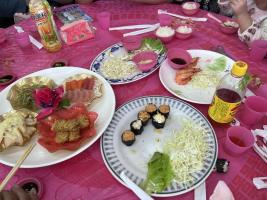※ 本文為 GETpoint.bbs. 轉寄自 ptt.cc 更新時間: 2021-10-21 22:21:05
看板 Gossiping
作者 標題 [新聞] 你騎的馬可能是在俄羅斯南部製造的
時間 Thu Oct 21 22:03:47 2021
備註請放最後面 違者新聞文章刪除
1.媒體來源:
外媒 THE NEW YORK TIMES
2.記者署名:
By Sabrina Imbler
3.完整新聞標題:
你騎的馬可能是在俄羅斯南部製造的
(過於喜感的機器翻譯,特予保留。)
4.完整新聞內文:
你騎的馬可能是在俄羅斯南部製造的
The Horse You Rode In On May Have Been Made in Southern Russia
一篇全面的新論文測試了 273 種古馬的基因組,以確定現代馬的馴化時間和地點。
A comprehensive new paper tested 273 ancient horse genomes to pinpoint when
and where modern horses were domesticated.
中國內蒙古草原上的馬。 法國古遺傳學家 Ludovic Orlando 於 2016 年開始在歐亞大陸
收集考古樣本,以積累龐大的數據集。
Horses of the steppes in Inner Mongolia, China. Ludovic Orlando, a French
paleogeneticist, began in 2016 collecting archaeological samples across
Eurasia to amass a huge data set.Credit...Ludovic Orlando
經過 薩布麗娜· 伊布勒
2021 年 10 月 20 日
幾千年來,歐洲和亞洲的草原是基因不同的馬血統鑲嵌的家園。但是一個單一的血統疾
馳而過,超越並取代了所有其他野馬。這個馴化的血統成為我們現代想像中的馬:修長的
腿、肌肉發達的背部和在風中閃閃發光的鬃毛。
幾十年來,科學家們一直試圖找出現代馬首次馴化的時間和地點。
For thousands of years, the grassy plains of Europe and Asia were home to a
mosaic of genetically distinct horse lineages. But a single lineage galloped
ahead to overtake and replace all the other wild horses. This domesticated
lineage became the horse of our modern imagination: slender legs, a muscular
back and a mane that shimmers in the wind.
For decades, scientists had tried to sleuth out when and where modern horses
were first domesticated but had yet to find the smoking hoof they needed.
現在,在周三發表在《自然》雜誌上的一篇論文中,科學家們終於解開了這個謎團。在收
集和測序了 273 個古馬基因組並測序後,一個由 162 位作者組成的團隊得出結論,現代
馬大約在 4200 年前在俄羅斯南部的草原上被馴化,靠近伏爾加河和頓河的交匯處。
集和測序了 273 個古馬基因組並測序後,一個由 162 位作者組成的團隊得出結論,現代
馬大約在 4200 年前在俄羅斯南部的草原上被馴化,靠近伏爾加河和頓河的交匯處。
挪威北極大學特羅姆瑟校區古基因組學研究員彼得· 海因茨曼(Peter Heintzman)並未
參與這項研究,他表示,這篇新論文目前盡可能地解開了家馬起源之謎。“這是一項巨大
的努力,”海因茨曼博士說,並指出他們從“數百匹馬”中收集了“數據牆”。
參與這項研究,他表示,這篇新論文目前盡可能地解開了家馬起源之謎。“這是一項巨大
的努力,”海因茨曼博士說,並指出他們從“數百匹馬”中收集了“數據牆”。
Now, in a paper published Wednesday in the journal Nature, scientists have
finally solved the mystery. After collecting and sequencing 273 ancient horse
genomes, a team of 162 authors concluded that modern horses were domesticated
around 4,200 years ago in steppes around southern Russia, near where the
Volga and Don rivers intersect.
This new paper comes as close as currently possible to solving the mystery of
the origins of the domestic horse, according to Peter Heintzman, a
paleogenomics researcher at the Tromso campus of the Arctic University of
Norway, who was not involved with the research. “It’s a monumental effort,
” Dr. Heintzman said, noting that they collected a “wall of data” from “
hundreds of horses.”
法國圖盧茲人類生物學和基因組學中心的古遺傳學家和研究主任、該論文的作者
Ludovic Orlando 已經為這個問題辛勤工作了十年。
近年來,學者們在哈薩克草原上的一個博泰定居點定居,那裡充滿了馬的骨頭碎片和內襯
似乎是馬奶的陶罐。這是馬馴化的最早考古證據,並且作為現代馬的發源地似乎很有希望
。
似乎是馬奶的陶罐。這是馬馴化的最早考古證據,並且作為現代馬的發源地似乎很有希望
。
Ludovic Orlando, a paleogeneticist and research director of the Center for
Anthropobiology and Genomics of Toulouse in France and an author on the
paper, has toiled over this question for a decade.
In recent years, scholars homed in on a Botai settlement in the Kazakh
steppes that was brimming with horses’ bone fragments and clay pots that
were lined with what appeared to be mare’s milk. This was the earliest
archaeological evidence of horse domestication, and seemed promising as the
birthplace of modern horses.
但在 2018 年,包括奧蘭多博士在內的一組研究人員在博泰對馬骨的基因組進行了測序。
令研究人員驚訝的是,博泰馬並沒有產生現代馬,而是普氏野馬的直系祖先,普氏原野馬
是一種粗壯的血統,最初被認為是地球上最後的野馬。他們發現普氏原羚畢竟不是野生的
,而是家養的野生後代。因此,現代馬的起源之謎仍未解開。“每次我都在期待什麼,結
果都是錯誤的,”奧蘭多博士說。
令研究人員驚訝的是,博泰馬並沒有產生現代馬,而是普氏野馬的直系祖先,普氏原野馬
是一種粗壯的血統,最初被認為是地球上最後的野馬。他們發現普氏原羚畢竟不是野生的
,而是家養的野生後代。因此,現代馬的起源之謎仍未解開。“每次我都在期待什麼,結
果都是錯誤的,”奧蘭多博士說。
他說,為了解開這個謎團,“我們決定詳盡無遺,真正到處尋找。”
But in 2018, a team of researchers including Dr. Orlando sequenced the
genomes of the horse bones at Botai. To the researchers’ surprise, the Botai
horses did not give rise to modern horses, but were instead the direct
ancestors of Przewalski’s horses, a stocky lineage originally thought to be
the last wild horses on the planet. They revealed Przewalski’s were not wild
after all, but instead the feral descendants of domestics. So the puzzle of
the origins of modern horses remained unsolved. “Every time I was expecting
something, it was wrong,” Dr. Orlando said.
He said that to solve the mystery, “we decided to be exhaustive and really
look everywhere.”
在這種情況下,任何地方都意味著整個歐亞大陸。從 2016 年開始,奧蘭多博士從考古收
藏品和新挖掘物中收集了該地區的樣本,基本上是他們可以拿到的每一塊古代馬骨。
為了將來保存這些遺骸,研究人員在古馬的內耳、牙齒和其他骨骼上鑽了小孔,以取回微
小的樣本。
Everywhere, in this case, meant across Eurasia. Starting in 2016, Dr. Orlando
collected samples across the region from archaeological collections and new
digs, essentially every ancient horse bone they could get their hands on.
To preserve the remains for the future, the researchers drilled tiny holes
into the ancient horses’ inner ears, teeth and other bones to retrieve tiny
samples.
隨著研究人員逐漸跨越時間和空間繪製馬的基因組圖,圖片變得更加清晰。一年多以前,
他們能夠確定準確的位置:現在俄羅斯境內的伏爾加河-頓河地區。
有瞭如此龐大的數據集,研究人員最終回答了額外的歷史細節。他們發現現代馬與其他古
代血統有兩個明顯的遺傳差異——一個基因與溫順有關,另一個與更強壯的脊椎有關——
這可能促進了動物的傳播。
代血統有兩個明顯的遺傳差異——一個基因與溫順有關,另一個與更強壯的脊椎有關——
這可能促進了動物的傳播。
As the researchers gradually mapped the horse genomes across time and space,
the picture became sharper. A little over a year ago, they were able to
pinpoint the precise location: the Volga-Don region in what is now Russia.
With such a gargantuan data set, the researchers ended up answering
additional horsy historical details. They found modern horses had two stark
genetic differences from other ancient lineages — one gene linked to
docility and another to a stronger backbone — which may have facilitated the
animals’ spread.
馴馬改變了人類歷史,使人們能夠長途跋涉並開發新的戰爭技術。“每個人都想要這匹馬
,”奧蘭多博士說。
因此,該論文的基因發現“構成了我們對培育這些馬的人類社會的理解的重大進展,”法
國國家科學研究中心的博士後研究員 Pauline Hanot 說,他沒有參與這項研究。
Domestic horses transformed human history, allowing people to travel great
distances and develop new technologies of warfare. “Everyone wanted the
horse,” Dr. Orlando said.
Accordingly, the paper’s genetic findings “constitute major advances in our
understanding of the human societies which bred these horses,” said Pauline
Hanot, a postdoctoral researcher at the French National Centre for Scientific
Research who was not involved with the research.
該研究還推翻了關於馬在早期人類歷史中的作用的觀點。例如,一個先前存在的理論表明
,大約 5000 年前,一個叫做顏那亞的牧民能夠在馬背上大量遷移到歐洲。但是新的基因
圖沒有發現任何證據;研究人員指出,牛,而不是馬,可能是它們擴張的驅動因素。
,大約 5000 年前,一個叫做顏那亞的牧民能夠在馬背上大量遷移到歐洲。但是新的基因
圖沒有發現任何證據;研究人員指出,牛,而不是馬,可能是它們擴張的驅動因素。
這篇新論文還揭示了大約 3800 年前,隨著青銅時代的辛塔什塔文化(Sintashta 文化)
傳播到歐亞大陸,該文化擁有輻條輪戰車。
The study also knocked down ideas about horses’ role in earlier human
history. For instance, one pre-existing theory suggested a pastoralist people
called the Yamnaya were able to migrate on horseback in massive numbers into
Europe around 5,000 years ago. But the new genetic map found no evidence; the
researchers point out oxen, not horses, could have been the driving factor of
their expansion.
The new paper also reveals domestic horses spread across Eurasia along with
the Bronze Age Sintashta culture, which possessed spoke-wheeled chariots,
around 3,800 years ago.
在馴服了所有這些馬匹數據後,奧蘭多博士有了一個新的愛好:他開始參加騎馬課程。
像所有其他人一樣,他騎著家馬——在俄羅斯南部馳騁的古老動物的後代。
“我不敢接近普氏原羚的馬,”奧蘭多博士說。“他們殺狼。我跑得沒那麼快。”
After taming all of this horse data, Dr. Orlando has taken on a new hobby: He
started taking riding lessons.
Like all other humans, he rides domestic horses — descendants of the ancient
animals that galloped in southern Russia.
“I would not dare approach a Przewalski’s horse,” Dr. Orlando said. “They
kill wolves. I am not that fast of a runner.”
5.完整新聞連結 (或短網址):
https://www.nytimes.com/2021/10/20/science/horse-domestication-russia.html
6.備註:
難怪哥薩克人的騎兵能在戰爭史上持續作戰這麼久
https://www.youtube.com/watch?v=A1k1hQQNfpg

同場加映TED短片:17世紀哥薩克戰士的日常
https://www.youtube.com/watch?v=33cP54FcERA

--
七魄興輪無上伊甸瑜珈雖然是以看來較為平和的方式以蟬蛻和生乳取代血肉等腥穢之物
作為密義源起供養;然而聚歛於上的是冥界的深冤與大樂奔瀉的淨慈,行者於閉關修持
之時若生起退失動搖之心,則神識旋即離散且肉身消殞;即便如此還是願意受灌頂嗎?
https://imgur.com/cEVD0kE ---妖道七祖《攝一切魔根本瑜珈論/誓命問品第一》---
文章代碼(AID): #1K0Lp7VP (CFantasy) [ptt.cc] Re: [新聞] 湖南偏鄉驚曝百餘......
https://imgur.com/eRQKYMF 文章網址: https://tinyurl.com/56ervywe
--
※ 發信站: 批踢踢實業坊(ptt.cc), 來自: 111.248.121.163 (臺灣)
※ 文章代碼(AID): #1XSND7yG (Gossiping)
※ 文章網址: https://www.ptt.cc/bbs/Gossiping/M.1634825031.A.F10.html
→ : 我沒馬子騎1F 125.227.36.139 台灣 10/21 22:04
推 : 嗆屁,沒馬騎啦!2F 223.140.242.187 台灣 10/21 22:04
推 : 馬奶3F 1.174.52.32 台灣 10/21 22:11
※ 編輯: GETpoint (111.248.121.163 臺灣), 10/21/2021 22:14:05--
※ 看板: Gossiping 文章推薦值: 0 目前人氣: 0 累積人氣: 660
作者 GETpoint 的最新發文:
![]() 旗津吃海產「連4道菜冷的」他怒走人!老闆秒端烏魚子...結帳傻眼 ▲上了四道菜全是冷食,原PO氣到喊停不吃了。(圖/翻攝爆怨公社) 網搜小組/劉維榛報導364F 211推 35噓
旗津吃海產「連4道菜冷的」他怒走人!老闆秒端烏魚子...結帳傻眼 ▲上了四道菜全是冷食,原PO氣到喊停不吃了。(圖/翻攝爆怨公社) 網搜小組/劉維榛報導364F 211推 35噓![]() 雞蛋價格不斷飆升 美農場組織呼籲調查 美國蛋價高漲,2023年1月4日(週四)鑽石吧市一家韓資超市20個大號非籠養雞蛋售價 9.99美元。(徐曼沅/大紀元) 更新 2023-01-23 10:03 A …51F 32推 1噓
雞蛋價格不斷飆升 美農場組織呼籲調查 美國蛋價高漲,2023年1月4日(週四)鑽石吧市一家韓資超市20個大號非籠養雞蛋售價 9.99美元。(徐曼沅/大紀元) 更新 2023-01-23 10:03 A …51F 32推 1噓![]() 火辣女師不教書了 改當「全職女友」靠男友養!一天這樣過超滿足 ▲ 霍金斯的開銷全由男友負擔。(圖/翻攝自TikTok) 記者陳宛貞/綜合外電報導155F 89推 13噓
火辣女師不教書了 改當「全職女友」靠男友養!一天這樣過超滿足 ▲ 霍金斯的開銷全由男友負擔。(圖/翻攝自TikTok) 記者陳宛貞/綜合外電報導155F 89推 13噓![]() Abandoned Chihuahua sets world record for oldest living dog at the age of 23 Spike, 23, from Ohio, h …14F 5推 2噓
Abandoned Chihuahua sets world record for oldest living dog at the age of 23 Spike, 23, from Ohio, h …14F 5推 2噓![]() 今天印度總理宣布印度只花了8年將牛奶產量提升了1.5倍,不但無需進口牛奶。 甚至坐實全世界四分之一的乳源產地,成為人類產乳政權的首席(第二名為美國)。 而聯合國糧食及農業組織調查發現牛奶缺口最大的國家 …21F 13推 3噓
今天印度總理宣布印度只花了8年將牛奶產量提升了1.5倍,不但無需進口牛奶。 甚至坐實全世界四分之一的乳源產地,成為人類產乳政權的首席(第二名為美國)。 而聯合國糧食及農業組織調查發現牛奶缺口最大的國家 …21F 13推 3噓
點此顯示更多發文記錄
回列表(←)
分享




